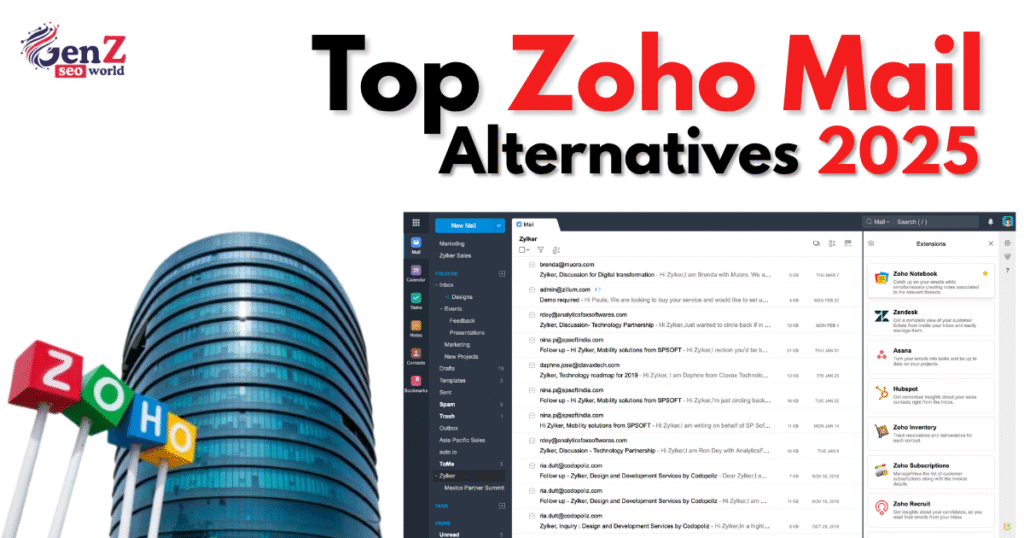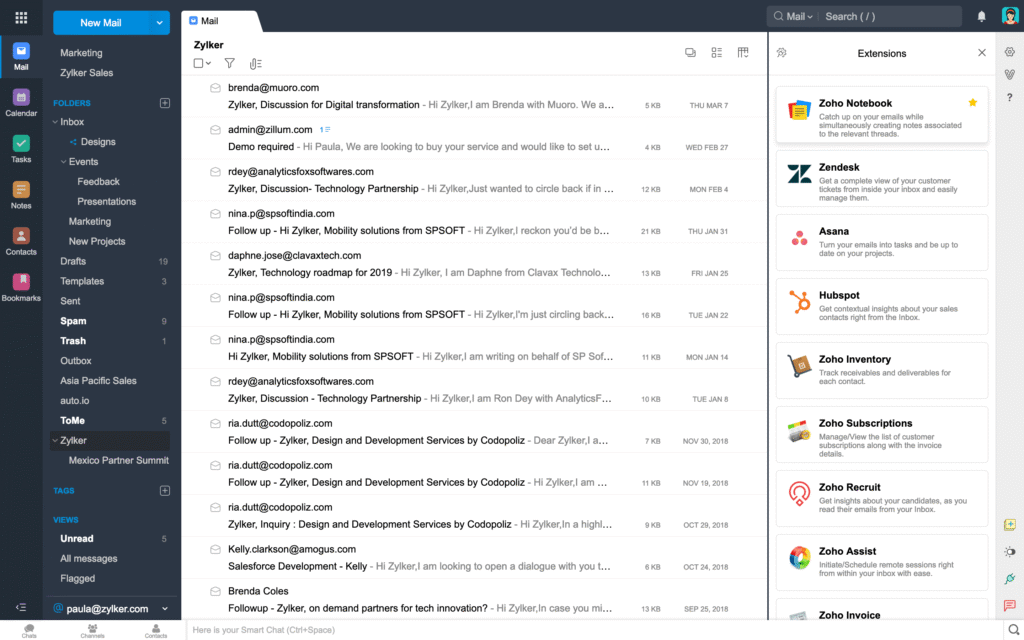
Hey there, fellow business owners and tech enthusiasts!
If you’re reading this in October 2025, chances are you’re knee-deep in evaluating your email setup. Maybe you’ve been using Zoho Mail for a while, or perhaps you’re just starting to explore business email software. Either way, I get it — finding something reliable, secure, and affordable isn’t always easy.
Zoho Mail definitely has its loyal fans, but it’s not the perfect fit for everyone. Some users find its integrations a bit clunky, while others need more advanced or specialized features for their growing teams.
In this post, we’ll break everything down like we’re chatting over coffee. First, we’ll look at what Zoho Mail offers, followed by an honest review based on real user experiences and expert insights. Then, we’ll explore the top Zoho Mail alternatives you can consider in 2025.
Along the way, we’ll naturally touch on popular search topics like “Zoho Mail alternatives,” “Zoho Mail review,” “email similar to Outlook,” and even “Zoho Corporation turnover” to give you full context about the brand and its ecosystem.
My goal? To help you make an informed, no-fluff decision about which email platform fits your business best. Everything here is backed by recent reviews, user discussions, and hands-on comparisons from trusted sources like PCMag, Reddit, and the Canary Mail blog.
What Is Zoho Mail? A Quick Primer
First things first: What is Zoho email? Zoho Mail is a cloud-based email hosting service designed primarily for businesses, offering secure, ad-free email with custom domains. It’s part of the larger Zoho ecosystem, which includes over 45 apps for CRM, project management, and more. Launched by Zoho Corporation (a bootstrapped giant from Chennai, India, with a reported revenue crossing $1 billion in FY23—more on “zoho corporation turnover” later), it’s aimed at small to medium-sized teams who want an affordable alternative to big players like Microsoft or Google.
Key features include:
- Storage and Domains: Starts with 5GB per user on free plans, scaling up to 50GB or more.
- Collaboration Tools: Built-in chat, calendar, tasks, and integration with Zoho’s suite.
- Security: Anti-spam, anti-phishing, encryption, and compliance options like HIPAA.
- Mobile and Desktop Access: Apps for iOS, Android, and web, with offline support on paid tiers.
- Customizability: Unlimited aliases, POP/IMAP support, and email delegation.
It’s navigational at heart—users often search for “zoho mail” when they need a straightforward business email setup. But if you’re wondering “what is Zoho email” in broader terms, it’s essentially a pillar in the world of business email software, competing with giants while keeping costs low. Founded by Sridhar Vembu (the “zoho founder” and CEO who stepped down in 2024 to focus on R&D), Zoho emphasizes privacy and no-ads, making it a go-to for privacy-conscious users.

Zoho Mail Review: The Good, the Bad, and the Realistic
Now, let’s talk “zoho mail review.” Based on my research from sources like PCMag (which gave it a solid 4.0/5 in their latest update) and user feedback on Reddit and G2, Zoho Mail shines in affordability and integration but stumbles on usability.
Pros:
- Generous Storage for the Price: Even the free plan offers 5GB per user, and Premium jumps to 50GB—perfect for growing teams without breaking the bank.
- Robust Security Controls: Features like native encryption, anti-phishing warnings, and SOC2/HIPAA compliance make it a safe bet for sensitive data.
- Seamless Zoho Integration: If you’re already in the Zoho world (e.g., using Zoho CRM or Docs), it’s a no-brainer. Tools like Streams (a social intranet) and eDiscovery for archiving add real value.
- Collaboration Powerhouse: Built-in chat, video meetings via Zoho Meeting, and shared inboxes make it great for teams.
Cons:
- Erratic Microsoft Compatibility: Users report issues syncing with Outlook or Exchange—ironic, given searches for “email similar to outlook” often lead here as an alternative, but it doesn’t always play nice.
- Confusing Navigation: The interface can feel overwhelming with Zoho’s app sprawl. Switching between email, calendar, and tasks isn’t as intuitive as in competitors.
- Limited Free Tier: Only 5 users max on free, and no custom domains without upgrading.
- Support Gaps: While 24/7 support exists on paid plans, free users rely on forums, which can be hit-or-miss.
Pricing Breakdown:
- Forever Free: $0/user/month – 5 users, 5GB storage, basic features.
- Mail Lite: $1/user/month – Adds offline access, multiple domains, and more storage options.
- Mail Premium: $4/user/month – 50GB storage, archiving, backups, and advanced admin controls.
- Workplace Bundle: $3/user/month – Includes Zoho Mail plus file storage, docs, and collaboration apps.
Overall, Zoho Mail earns its stripes for value—especially if your team is under 50 and you want an “email client similar to outlook” without the Microsoft price tag. But if you’re dealing with “zoho public” forms scams (a common search tangent where fake Zoho links pop up in rentals—always verify via official sites), or need better Outlook-like features, it’s time to look elsewhere. User reviews on G2 average 4.3/5, praising reliability but docking points for the learning curve.
Fun fact on the company side: Zoho Corporation’s turnover (or revenue) hit over $1 billion in 2023, growing 30% year-over-year without external funding. This bootstrapped model (led by “who owns zoho”—Sridhar Vembu and siblings) keeps prices low but might explain the occasional feature lag.
Why Consider Zoho Mail Alternatives?
Look, Zoho Mail is solid, but no tool is perfect. Common pain points from searches like “zoho mail alternatives” include:
- Ecosystem Lock-In: If you’re not all-in on Zoho, integrations feel forced.
- Outlook-Like Needs: Queries for “email similar to outlook” or “mail client like outlook” highlight desires for better Microsoft compatibility or a more familiar interface.
- Privacy/Security Focus: Some want end-to-end encryption beyond Zoho’s offerings.
- Scalability: Larger teams or those needing “zoho alternatives free” might outgrow the limits.
- Cost or Features: With “zoho revenue” booming, prices are competitive, but free tiers elsewhere offer more.
If these resonate, here are my top picks for 2025, drawn from recent comparisons on sites like Clean Email, Canary Mail’s blog, and Pumble. I focused on business-friendly options with strong reviews (4+ stars on G2/PCMag).
Top 10 Zoho Mail Alternatives in 2025
I’ll cover key features, pros/cons, pricing, and why it’s a fit. These span free to enterprise, including “email app like outlook” vibes.
1. Microsoft Outlook (via Microsoft 365)
If you’re searching for “email client like outlook” or “alternatives to outlook” (ironically), this is the gold standard for Microsoft fans.
- Key Features: Focused inbox, email scheduling, integration with Teams/OneDrive, robust search, and AI-powered summaries.
- Pros: Seamless with Windows/Office, enterprise security, unlimited storage on higher plans.
- Cons: Pricier; privacy concerns with data scanning.
- Pricing: Free personal; Business starts at $6/user/month.
- Why a Good Alternative: Perfect for teams needing “mail programs like outlook” with better compatibility than Zoho’s erratic MS sync.
2. Google Workspace (Gmail for Business)
A top “zoho alternatives free” contender with a free personal tier.
- Key Features: 15GB+ storage, spam filtering, confidential mode, Google integrations (Docs, Meet).
- Pros: Intuitive, offline mode, strong mobile app.
- Cons: No end-to-end encryption; Google ecosystem dependency.
- Pricing: Free personal; Business $6/user/month.
- Why a Good Alternative: Simpler than Zoho for Google users, with “email software like outlook” familiarity via labels and search.
3. Proton Mail
Best for privacy, often in “zoho mail alternatives” lists.
- Key Features: End-to-end encryption, aliases, advanced search, integrated calendar/VPN.
- Pros: Zero-access encryption, no ads, GDPR compliant.
- Cons: Limited free storage (500MB), slower speeds.
- Pricing: Free; Pro $3.99/user/month.
- Why a Good Alternative: Addresses Zoho’s security gaps for sensitive industries, like “z email” secure options.
4. Canary Mail
Promoted as the “best Zoho Mail alternative overall” in recent blogs.
- Key Features: AI email writer, one-click unsubscribes, unified inbox, biometric lock.
- Pros: Modern interface, strong security (PGP), 28-day trial.
- Cons: Learning curve for AI features.
- Pricing: Free personal; $49/year pro.
- Why a Good Alternative: More productivity-focused than Zoho, ideal for “email client similar to outlook” with AI twists.
5. Spark Mail
A sleek “mail client like outlook” option.
- Key Features: Smart inbox, email templates, snooze, team collaboration.
- Pros: Free for individuals, intuitive on Mac/iOS.
- Cons: No Windows app; premium for teams.
- Pricing: Free; Teams $7.99/user/month.
- Why a Good Alternative: Handles multiple accounts better than Zoho, great for solopreneurs.
6. Mailspring
Lightweight “email software similar to outlook.”
- Key Features: Unified inbox, shortcuts, read receipts, dark mode.
- Pros: Open-source, fast, supports IMAP.
- Cons: No mobile app; pro features paid.
- Pricing: Free; Pro $8/month.
- Why a Good Alternative: Desktop-focused, avoids Zoho’s web clutter.
7. Titan Mail
For a “smart email experience.”
- Key Features: Templates, reminders, calendar, custom domains.
- Pros: High uptime, delivery notifications.
- Cons: Partner-dependent pricing.
- Pricing: Varies ($1-3/user/month via hosts like Hostinger).
- Why a Good Alternative: Reliable for custom domains, less complex than Zoho.
8. Tuta (formerly Tutanota)
Secure “zoho alternatives free” pick.
- Key Features: Encryption, aliases, calendar.
- Pros: Ad-free, open-source elements.
- Cons: No IMAP/POP support.
- Pricing: Free; Premium €1/month.
- Why a Good Alternative: Privacy-first, echoes Zoho’s no-ads but with stronger encryption.
9. iCloud Mail
Best for Apple users.
- Key Features: 5GB free storage, aliases, integration with Apple ecosystem.
- Pros: Seamless on iOS/Mac, strong privacy.
- Cons: Limited for non-Apple devices.
- Pricing: Free; iCloud+ $0.99/month for more storage.
- Why a Good Alternative: Simple “email programs like outlook” for personal/business hybrids.
10. Fastmail
Reliable paid option.
- Key Features: Custom domains, aliases, advanced filtering.
- Pros: Fast, private, no tracking.
- Cons: No free tier.
- Pricing: $5/user/month.
- Why a Good Alternative: Balances Zoho’s features with better speed and independence.
Comparison Table: Zoho Mail vs. Alternatives
| Provider | Storage (Base) | Pricing (Starting) | Key Strength | Best For |
|---|---|---|---|---|
| Zoho Mail | 5GB | Free / $1/mo | Integration | Zoho ecosystem users |
| Microsoft 365 | Unlimited | $6/mo | MS compatibility | Enterprise teams |
| Google Workspace | 15GB | $6/mo | Ease of use | Google fans |
| Proton Mail | 500MB | Free / $3.99/mo | Privacy | Security-focused |
| Canary Mail | Varies | Free / $49/yr | AI features | Productivity pros |
| Spark Mail | Varies | Free / $7.99/mo | Smart inbox | Mac users |
| Mailspring | Varies | Free / $8/mo | Lightweight | Desktop enthusiasts |
| Titan Mail | Varies | ~$1-3/mo | Reliability | Custom domains |
| Tuta | 1GB | Free / €1/mo | Encryption | Budget privacy |
| iCloud Mail | 5GB | Free / $0.99/mo | Apple integration | iOS users |
| Fastmail | 2GB | $5/mo | Speed | Independent pros |
Wrapping Up: Which Zoho Mail Alternative Should You Choose?
If you’re sticking with Zoho Mail, you’re still in good hands. It’s a powerhouse for integrated workflows, especially with Zoho Corporation’s impressive revenue growth fueling constant updates and innovation. But if you’re exploring alternatives, there are some strong contenders worth checking out. Go with Microsoft 365 if you’re looking for an email similar to Outlook, Proton Mail if privacy is your top priority, or Canary Mail if you want a modern, AI-powered email experience.
Frequently Asked Questions
What is Zoho Mail and how does it compare to Outlook?
Zoho Mail is a business-oriented email service with features like custom domains, collaboration tools, and strong security, all at a lower cost than many competitors. Compared to Outlook (via Microsoft 365), Zoho offers better affordability and no-ads privacy, but it may lack the seamless Microsoft integrations and polished interface that Outlook provides. If you’re looking for an “email similar to outlook,” Zoho is a close contender for small teams, but Outlook edges out for enterprise-scale needs.
What are the best free Zoho Mail alternatives?
Top free alternatives include Proton Mail (with end-to-end encryption and 500MB storage), Spark Mail (smart features for individuals), and Tuta (ad-free secure email with 1GB storage). These are great “zoho alternatives free” options if you’re moving away from Zoho’s limited free tier, offering solid basics without upfront costs. For more features, consider upgrading to their paid plans.
Is Zoho Mail worth it in 2025, considering the company’s growth?
Absolutely, especially for integrated ecosystems—Zoho Corporation’s turnover exceeded $1 billion in FY23 with 30% growth, fueling ongoing improvements like AI enhancements. However, if you need better Outlook compatibility or stricter privacy, explore “zoho mail alternatives” like Microsoft 365 or Proton Mail. User reviews highlight its value, but scalability for larger teams might push you toward bigger players.








